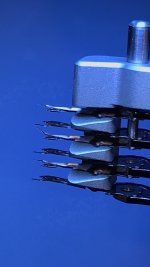You are using an out of date browser. It may not display this or other websites correctly.
You should upgrade or use an alternative browser.
You should upgrade or use an alternative browser.
st3000DM001 head issues?
- Thread starter Freakazoid
- Start date
Freakazoid
Member
Blizzard":k9f3b1im said:[post]12797[/post] In this particular case I would be surprised if there aren't matching rings on at least one other surface. If you inspect the heads and only the top surface appears to be damaged then you could try, but with that type of damage all surfaces are probably dirty now. When a customer opens a drive and ruins the top surface you have a better chance of recovery than a case like yours with catastrophic failure. Here is an example of a 3TB DM recovery with the top surface damaged because it was shipped with the top cover removed. Over 13,000 files with no errors recovered and 2700 videos that could still be played, with defects.
The DM series seems to be the drive of choice for customers to open and just "have a peek". Some we have recovered without removing the top head, but the one I have mentioned here had to have the top head removed from the donor HSA before we could perform the recovery.
Nice job
This scratch is after it fell to the ground, so I think it is possible, there is some more platter with damage ...
What is the best microscope to control your head with? and how do I see if a head is good or bad / dirty
Blizzard
Member
Thank you, Larry.LarrySabo":2pmd1i9d said:Wow, David. Nice job!
Blizzard
Member
I'm sure you will get plenty of arguments if someone posts "the best". We use a 20x-40x for viewing heads and a 10x-30x for flash repair. You can purchase them with .5 and/or 2x barlow lenses to make them have more or less magnification. One scope could do both jobs in the beginning but flash repair can be a dirty business so you'll eventually want more than one. Amscope makes reasonably priced professional and educational microscopes. If you have a bigger budget you might look at Meiji Techno.Freakazoid":2w9w3tr6 said:What is the best microscope to control your head with? and how do I see if a head is good or bad / dirty
Once you look at clean sliders under the scope you will see the unique patterns and uniform smoothness. When you compare that to heads from platter damaged drives you might see a gray mud-like coating that indicates the surface lubricant is coming off the platters. For severe damage you will actually see metal shavings. Sometimes the metal shavings roll up in clumps that look similar to stainless steel scouring pads. Sometimes you'll see marks that look like the sliders have been hit with sandpaper.
The world is quite different when it's viewed under a microscope
Freakazoid
Member
Yes I know.. same if I ask what you recommend.. I think the one I have is 7x-45x with .5 Barlow lens. I use it for MacBook logic board repair.. should I have over light, light on side or under light ?
Blizzard
Member
OK, if you are doing logicboard repair then you already know things can get messyFreakazoid":3664kc9w said:Yes I know.. same if I ask what you recommend.. I think the one I have is 7x-45x with .5 Barlow lens. I use it for MacBook logic board repair.. should I have over light, light on side or under light ?
I mostly use an LED ring light on the scope. Sometimes using a tinted led flashlight from the side can improve the quality of photos. Side light also helps when reading chips, but you already know that.
Freakazoid
Member
Blizzard
Member
Increase magnification then look at an angle to view the slider surfaces. The 3rd head from the top has a bent tip so pay close attention to that one in particular. See if they are clean or have mud on them. Also look for metal shavings around the slider. Jared has this video on his youtube channel that shows him cleaning heads, you can see what to look for in that video.

